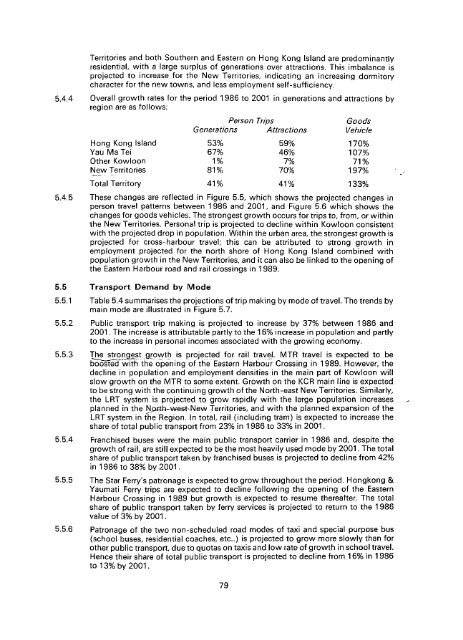Untitled - HKU Libraries - The University of Hong Kong
Untitled - HKU Libraries - The University of Hong Kong
Untitled - HKU Libraries - The University of Hong Kong
- No tags were found...
You also want an ePaper? Increase the reach of your titles
YUMPU automatically turns print PDFs into web optimized ePapers that Google loves.
Territories and both Southern and Eastern on <strong>Hong</strong> <strong>Kong</strong> Island are predominantlyresidential, with a large surplus <strong>of</strong> generations over attractions. This imbalance isprojected to increase for the New Territories, indicating an increasing dormitorycharacter for the new towns, and less employment self-sufficiency.5.4.4 Overall growth rates for the period 1986 to 2001 in generations and attractions byregion are as follows:Person TripsGoodsGenerations Attractions Vehicle<strong>Hong</strong> <strong>Kong</strong> Island 53% 59% 170%YauMaTei 67% 46% 107%Other Kowloon 1% 7% 71%New Territories 81% 70% 197%Total Territory 41 % 41 % 133%5.4.5 <strong>The</strong>se changes are reflected in Figure 5.5, which shows the projected changes inperson travel patterns between 1986 and 2001, and Figure 5.6 which shows thechanges for goods vehicles. <strong>The</strong> strongest growth occurs for trips to, from, or withinthe New Territories. Personal trip is projected to decline within Kowioon consistentwith the projected drop in population. Within the urban area, the strongest growth isprojected for cross-harbour travel; this can be attributed to strong growth inemployment projected for the north shore <strong>of</strong> <strong>Hong</strong> <strong>Kong</strong> Island combined withpopulation growth in the New Territories, and it can also be linked to the opening <strong>of</strong>the Eastern Harbour road and rail crossings in 1 989.5.5 Transport Demand by Mode5.5.1 Table 5.4 summarises the projections <strong>of</strong> trip making by mode <strong>of</strong> travel. <strong>The</strong> trends bymain mode are illustrated in Figure 5.7.5.5.2 Public transport trip making is projected to increase by 37% between 1986 and2001. <strong>The</strong> increase is attributable partly to the 16% increase in population and partlyto the increase in personal incomes associated with the growing economy.5.5.3 <strong>The</strong> strongest jgrowth is projected for rail travel. MTR travel is expected to beboosted"" with the opening <strong>of</strong> the Eastern Harbour Crossing in 1989. However, thedecline in population and employment densities in the main part <strong>of</strong> Kowloon willslow growth on the MTR to some extent. Growth on the KCR main line is expectedto be strong with the continuing growth <strong>of</strong> the North-east New Territories. Similarly,the LRT system is projected to grow rapidly with the large population increasesplanned in the Npitivw-es^WewTerritories, and with the planned expansion <strong>of</strong> theLRT system in the Region. In total, rail (including tram) is expected to increase theshare <strong>of</strong> total public transport from 23% in 1986 to 33% in 2001.5.5.4 Franchised buses were the main public transport carrier in 1986 and, despite thegrowth <strong>of</strong> rail, are still expected to be the most heavily used mode by 2001. <strong>The</strong> totalshare <strong>of</strong> public transport taken by franchssed buses is projected to decline from 42%in 1986 to 38% by 2001.5.5.5 <strong>The</strong> Star Ferry's patronage is expected to grow throughout the period. <strong>Hong</strong>kong &Yaumati Ferry trips are expected to decline following the opening <strong>of</strong> the EasternHarbour Crossing in 1989 but growth is expected to resume thereafter. <strong>The</strong> totalshare <strong>of</strong> public transport taken by ferry services is projected to return to the 1986value <strong>of</strong> 3% by 2001.5.5.6 Patronage <strong>of</strong> the two non-scheduled road modes <strong>of</strong> taxi and special purpose bus(school buses, residential coaches, etc..) is projected to grow more slowly than forother public transport, due to quotas on taxis and low rate <strong>of</strong> growth in school travel.Hence their share <strong>of</strong> total public transport is projected to decline from 16% in 1986to 13% by 2001.79
















